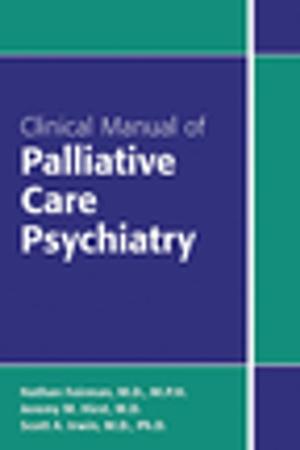Handbook of Diagnosis and Treatment of Bipolar Disorders
Nonfiction, Health & Well Being, Psychology, Psychiatry, Medical, Specialties| Author: | ISBN: | 9781585628995 | |
| Publisher: | American Psychiatric Publishing | Publication: | August 26, 2009 |
| Imprint: | American Psychiatric Association Publishing | Language: | English |
| Author: | |
| ISBN: | 9781585628995 |
| Publisher: | American Psychiatric Publishing |
| Publication: | August 26, 2009 |
| Imprint: | American Psychiatric Association Publishing |
| Language: | English |
This readable guide to the assessment and management of patients with bipolar disorder can help physicians keep abreast of dramatic and rapid advances of recent years and integrate them into their practice. Handbook of Diagnosis and Treatment of Bipolar Disorders emphasizes recent controlled studies and FDA-approved indications and translates these data into the real world of clinical practice. The contributions of the eleven chapter authors from Stanford University reflect more than a decade of clinical research and treatment undertaken at that institution, including advances in diagnosis and interventions supported by controlled studies. They provide crucial information regarding diagnosis, pharmacotherapy, psychotherapy, and treatment of patients from special populations -- such as children, women, and older adults -- and patients with particular challenging illness course such as rapid cycling.
This is the first book to provide quantitative assessment of potential benefit (number needed to treat) and risk (number needed to harm) for all approved treatments for bipolar disorder, providing clinicians with information needed to balance benefits and risks in order to render individualized state-of-the-art, evidence-based care. It describes all FDA-approved indications -- reviewing efficacy, safety, tolerability, pharmacokinetics, illness phase-specific dosing, and drug interactions. A chapter on multiphase treatment strategy explains crucial illness transition points and describes how these have been integrated with knowledge of illness phase in mood disorders. The book then demonstrates the relevance of this approach to therapeutics by providing: An overview of pharmacotherapy that covers the emergence of evidence-based pharmacotherapy and number-needed-to-treat and -harm analyses. Guidelines to managing acute manic and mixed episodes that include evidence-based assessments of lithium, divalproex, carbamazepine, and second-generation antipsychotics. Coverage of acute major depressive episodes in bipolar disorders that outlines four tiers of treatment for this most pervasive illness phase with the fewest approved treatments. Discussion of the longer-term management of bipolar disorders, including reviews of controlled trials of recently approved pharmacotherapies such as lamotrigine, olanzapine, aripiprazole, and adjunctive quetiapine. A review of the use of mood stabilizers and second-generation antipsychotics, often in combinations, as well as the controversial role of adjunctive antidepressants in treating patients with rapid-cycling bipolar disorders. Description of important advances in evidence-based adjunctive psychotherapeutic interventions in bipolar depression, and bipolar maintenance treatment.
Comprehensive in scope, yet readily accessible for application to clinical practice, the book includes summary tables, quick-reference lists of clinical pearls, and case studies to make its content more relevant. Handbook of Diagnosis and Treatment of Bipolar Disorders is the ideal source for integrating recent research into everyday practice.
This readable guide to the assessment and management of patients with bipolar disorder can help physicians keep abreast of dramatic and rapid advances of recent years and integrate them into their practice. Handbook of Diagnosis and Treatment of Bipolar Disorders emphasizes recent controlled studies and FDA-approved indications and translates these data into the real world of clinical practice. The contributions of the eleven chapter authors from Stanford University reflect more than a decade of clinical research and treatment undertaken at that institution, including advances in diagnosis and interventions supported by controlled studies. They provide crucial information regarding diagnosis, pharmacotherapy, psychotherapy, and treatment of patients from special populations -- such as children, women, and older adults -- and patients with particular challenging illness course such as rapid cycling.
This is the first book to provide quantitative assessment of potential benefit (number needed to treat) and risk (number needed to harm) for all approved treatments for bipolar disorder, providing clinicians with information needed to balance benefits and risks in order to render individualized state-of-the-art, evidence-based care. It describes all FDA-approved indications -- reviewing efficacy, safety, tolerability, pharmacokinetics, illness phase-specific dosing, and drug interactions. A chapter on multiphase treatment strategy explains crucial illness transition points and describes how these have been integrated with knowledge of illness phase in mood disorders. The book then demonstrates the relevance of this approach to therapeutics by providing: An overview of pharmacotherapy that covers the emergence of evidence-based pharmacotherapy and number-needed-to-treat and -harm analyses. Guidelines to managing acute manic and mixed episodes that include evidence-based assessments of lithium, divalproex, carbamazepine, and second-generation antipsychotics. Coverage of acute major depressive episodes in bipolar disorders that outlines four tiers of treatment for this most pervasive illness phase with the fewest approved treatments. Discussion of the longer-term management of bipolar disorders, including reviews of controlled trials of recently approved pharmacotherapies such as lamotrigine, olanzapine, aripiprazole, and adjunctive quetiapine. A review of the use of mood stabilizers and second-generation antipsychotics, often in combinations, as well as the controversial role of adjunctive antidepressants in treating patients with rapid-cycling bipolar disorders. Description of important advances in evidence-based adjunctive psychotherapeutic interventions in bipolar depression, and bipolar maintenance treatment.
Comprehensive in scope, yet readily accessible for application to clinical practice, the book includes summary tables, quick-reference lists of clinical pearls, and case studies to make its content more relevant. Handbook of Diagnosis and Treatment of Bipolar Disorders is the ideal source for integrating recent research into everyday practice.















